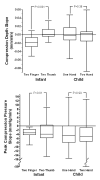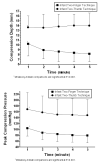Effect of alternative chest compression techniques in infant and child on rescuer performance
- PMID: 19307812
- PMCID: PMC4088329
- DOI: 10.1097/PCC.0b013e31819886ab
Effect of alternative chest compression techniques in infant and child on rescuer performance
Abstract
Objective: Current chest compression (CC) guidelines for an infant recommend a two-finger (TF) technique with lone rescuer and a two- thumb (TT) technique with two rescuers, and for a child either an one hand (OH) or a two hand (TH) technique with one or two rescuers. The effect of a 30:2 compression:ventilation ratio using these techniques on CC quality and rescuer fatigue is unknown. We hypothesized that during lone rescuer CC, TT technique, in infant and TH in child achieve better compression depth (CD) without additional rescuer fatigue compared with TF and OH, respectively.
Design: Randomized observational study.
Setting: University-affiliated pediatric hospital.
Subjects: Adult healthcare providers certified in basic life support or pediatric advanced life support.
Interventions: Laerdal baby advanced life support trainer and Resusci junior manikin were modified to digitally record CD, compression pressure (CP) and compression rate. Sixteen subjects were randomized to each of the four techniques to perform 5 minutes of lone rescuer 30:2 compression:ventilation cardiopulmonary resuscitation. Rescuer heart rate (HR) and respiratory rate were recorded continuously and the recovery time interval for HR/respiratory rate to return to baseline was determined. Subjects were blinded to data recording. Groups were compared using two-sample, two-sided Student's t tests.
Measurements and main results: Two-thumb technique generated significantly higher CD and peak CP compared with TF (p < 0.001); there was no significant difference between OH vs. TH. TF showed decay of CD and CP over time compared with TT. Compression rate (per minute) and actual compressions delivered were not significantly different between groups. No significant differences in fatigue and recovery time were observed, except the TT group had greater increase in the rescuer's HR (bpm) from baseline compared with TF group (p = 0.04).
Conclusions: Two-thumb compression provides higher CD and CP compared with TF without any evidence of decay in quality and additional rescuer fatigue over 5 minutes. There was no significant difference in child CC quality or rescuer fatigue between OH and TH. Two-thumb technique is preferred for infant CC and our data support the current guidelines for child CC.
Figures



Comment in
-
Improving pediatric cardiopulmonary resuscitation techniques on manikins: one small step for critical care medicine... one giant leap for mankind!Pediatr Crit Care Med. 2009 May;10(3):407-9. doi: 10.1097/PCC.0b013e31819ae0ec. Pediatr Crit Care Med. 2009. PMID: 19433947 No abstract available.
Similar articles
-
Chest compression quality and rescuer fatigue with increased compression to ventilation ratio during single rescuer pediatric CPR.Resuscitation. 2008 Oct;79(1):82-9. doi: 10.1016/j.resuscitation.2008.04.026. Epub 2008 Jul 9. Resuscitation. 2008. PMID: 18617314 Clinical Trial.
-
Two-thumb technique is superior to two-finger technique during lone rescuer infant manikin CPR.Resuscitation. 2010 Jun;81(6):712-7. doi: 10.1016/j.resuscitation.2009.12.029. Epub 2010 Mar 12. Resuscitation. 2010. PMID: 20227156 Clinical Trial.
-
Two-thumb-encircling hands technique is more advisable than 2-finger technique when lone rescuer performs cardiopulmonary resuscitation on infant manikin.Am J Emerg Med. 2015 Apr;33(4):531-4. doi: 10.1016/j.ajem.2015.01.025. Epub 2015 Jan 21. Am J Emerg Med. 2015. PMID: 25667159 Clinical Trial.
-
Comparison of two-thumb encircling and two-finger technique during infant cardiopulmonary resuscitation with single rescuer in simulation studies: A systematic review and meta-analysis.Medicine (Baltimore). 2019 Nov;98(45):e17853. doi: 10.1097/MD.0000000000017853. Medicine (Baltimore). 2019. PMID: 31702646 Free PMC article.
-
A comparison between the two methods of chest compression in infant and neonatal resuscitation. A review according to 2010 CPR guidelines.J Matern Fetal Neonatal Med. 2018 Mar;31(6):805-816. doi: 10.1080/14767058.2017.1295953. Epub 2017 Mar 5. J Matern Fetal Neonatal Med. 2018. PMID: 28282762 Review.
Cited by
-
Two-Thumb or Two-Finger Technique in Infant Cardiopulmonary Resuscitation by a Single Rescuer? A Meta-Analysis with GOSH Analysis.Int J Environ Res Public Health. 2020 Jul 19;17(14):5214. doi: 10.3390/ijerph17145214. Int J Environ Res Public Health. 2020. PMID: 32707697 Free PMC article.
-
Analysis of Chest-Compression Depth and Full Recoil in Two Infant Chest-Compression Techniques Performed by a Single Rescuer: Systematic Review and Meta-Analysis.Int J Environ Res Public Health. 2020 Jun 5;17(11):4018. doi: 10.3390/ijerph17114018. Int J Environ Res Public Health. 2020. PMID: 32516929 Free PMC article.
-
Rescuer Exertion and Fatigue Using Two-Thumb vs. Two-Finger Method During Simulated Neonatal Cardiopulmonary Resuscitation.Front Pediatr. 2020 Apr 2;8:133. doi: 10.3389/fped.2020.00133. eCollection 2020. Front Pediatr. 2020. PMID: 32300578 Free PMC article.
-
Part 10: Pediatric basic and advanced life support: 2010 International Consensus on Cardiopulmonary Resuscitation and Emergency Cardiovascular Care Science With Treatment Recommendations.Circulation. 2010 Oct 19;122(16 Suppl 2):S466-515. doi: 10.1161/CIRCULATIONAHA.110.971093. Circulation. 2010. PMID: 20956258 Free PMC article.
-
Neonatal resuscitation: evolving strategies.Matern Health Neonatol Perinatol. 2015 Jan;1:4. doi: 10.1186/s40748-014-0003-0. Matern Health Neonatol Perinatol. 2015. PMID: 25918640 Free PMC article.
References
-
- 2005 American Heart Association Guidelines for Cardiopulmonary Resuscitation and Emergency Cardiovascular Care. Circulation. 2005;112:IV1–203. - PubMed
-
- 2005 American Heart Association (AHA) guidelines for cardiopulmonary resuscitation (CPR) and emergency cardiovascular care (ECC) of pediatric and neonatal patients: pediatric basic life support. Pediatrics. 2006;117:e989–1004. - PubMed
-
- The International Liaison Committee on Resuscitation (ILCOR) consensus on science with treatment recommendations for pediatric and neonatal patients: neonatal resuscitation. Pediatrics. 2006;117:e978–988. - PubMed
-
- Houri PK, Frank LR, Menegazzi JJ, et al. A randomized, controlled trial of two-thumb vs. two-finger chest compression in a swine infant model of cardiac arrest [see comment] Prehosp Emerg Care. 1997;1:65–67. - PubMed
-
- Menegazzi JJ, Auble TE, Nicklas KA, et al. Two-thumb versus two-finger chest compression during CRP in a swine infant model of cardiac arrest. Ann Emerg Med. 1993;22:240–243. - PubMed
Publication types
MeSH terms
Grants and funding
LinkOut - more resources
Full Text Sources
Medical
Miscellaneous

